Building a music recommendation engine
This exercise is inspired by the Music Recommendation Challenge KAGGLE competition.
The data was provided by KKBOX, an East-Asian music streaming service, similar to Spotify. It shows the first observable listening event for each unique user-song pair, together with potenitally useful Metadata. Besides the data provided, I sourced additional song and artist information via the API of Deezer music streaming service based on a ‘real-world’ unique song identifier (ISRC id) in the KKBOX dataset
My objective utlizing classification models was to predict… …if a user is listening to a song repetitively …after the first observable listening event …within a month window was triggered
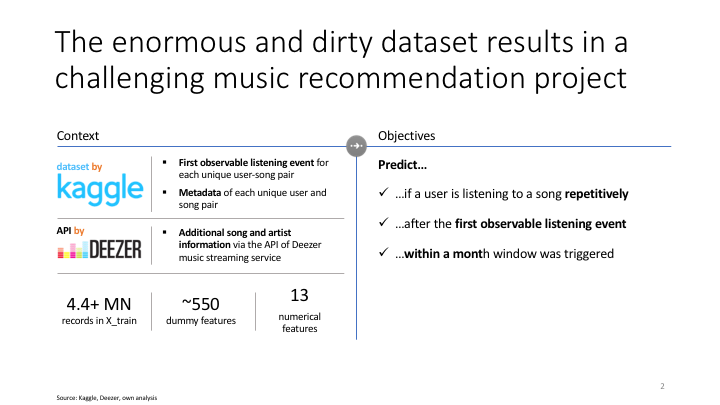
# Import all necessery python packages
import pandas as pd
import numpy as np
import matplotlib.pyplot as plt
import matplotlib.dates as mdates
import time
import seaborn as sns
from collections import defaultdict
import statsmodels.api as sm
import statsmodels.formula.api as smf
import swifter
from math import ceil
import pickle as pkl
from sklearn.linear_model import LogisticRegression
from sklearn.preprocessing import StandardScaler
from sklearn.metrics import fbeta_score, confusion_matrix
from sklearn.ensemble import RandomForestClassifier
import xgboost as xgb
from IPython.display import Image
%matplotlib inline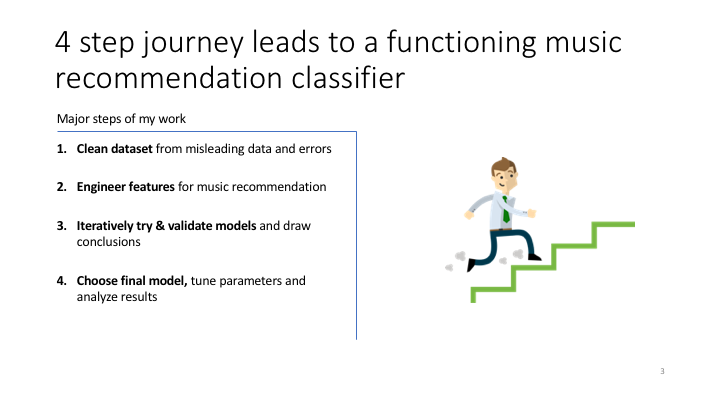
1. Read in the data
The data is available on via the KAGGLE here, you may have to register if you are not a member yet - it is free of charge.
By the way, KAGGLE is a really interesting source and platform to practice data science problems, and to acquire data. I highly recommend it!
KAGGLE data
def read_in_data(sample):
'''
Reads in data from music_data folder in pickle format. If sample arguement is True, it limits each df to 1000
randomly sampled rows.
input: None
output: df_train, df_members, df_full_songs
'''
# Limiting the data to 1000 records from each db
df_train = pd.read_pickle('./music_data/train.pkl')
df_members = pd.read_pickle('./music_data/members.pkl')
df_full_songs = pd.read_pickle('./music_data/df_full_songs.pkl')
if sample:
df_train = df_train.sample(1000)
df_members = df_members.sample(1000)
df_full_songs = df_full_songs.sample(1000)
return df_train, df_members, df_full_songsDeezer data
def downloader(df_merged):
'''
Download data from deezer
input: df_merged
otuput: dict containing the API download data
'''
BASE_URL = 'https://api.deezer.com/2.0/track/isrc:'
unique_isrc = df_merged['isrc'].unique()
total = len(unique_isrc)
from IPython.display import clear_output, display
for i, isrc in enumerate(unique_isrc):
if not dict[str(isrc)]:
clear_output(wait=True)
try:
api_call = BASE_URL + str(isrc)
r = req.get(api_call).content
dict[str(isrc)] = r
print('Saved:',str(isrc),i,'of',total)
except:
print('***Failed:***',str(isrc),i,'of',total)
downloader(df_merged)
def save_deezer_to_pickle(dict):
'''
input: dict with downloaded deezer api info
output: none, saves dict to pickle
'''
# Save the downloaded data to a pkl file
with open('deezer_data.pkl', 'wb') as handle:
pickle.dump(dict, handle, protocol=pickle.HIGHEST_PROTOCOL)
def deezer_into_df(dict):
'''
Take the dict with the downloaded API data
input: dict with downloaded api info
output: df_isrc in memory and saved to disk, containing the useful info from
'''
import json
dfs=[]
for key, value in dict.items():
json1_data = json.loads(value)
try:
isrc_query = np.array([
key,
json1_data['title'],
json1_data['album']['title'],
json1_data['artist']['name'],
json1_data['release_date'],
json1_data['duration'],
json1_data['track_position'],
json1_data['bpm'],
json1_data['gain'],
json1_data['rank']
])
df_isrc_query = pd.DataFrame(isrc_query.reshape(1,isrc_query.size))
dfs.append(df_isrc_query)
except:
try:
if json1_data['error']['code'] == 800:
pass #all response 800 just pass
except:
print(key,'/n', json1_data)
pass
df_isrc_all = pd.concat(dfs)
df_isrc_all.columns = ['isrc','track_title','album_title','artist_name','release_date','duration_sec','track_pos','bpm','gain','rank']
df_isrc_all.reset_index(inplace=True)
del df_isrc_all['index']
df_isrc_all.to_pickle('df_isrc.pkl')
return df_isrc_allMerging deezer and kaggle data
def create_df_full_songs(df_song_extra,df_songs,df_isrc):
'''
Merging the relationally stored sub-tables that describe the metadata for each song into a single table
input: df_song_extra,df_songs,df_isrc
output: df_full_songs
'''
df_song_extra = pd.read_pickle('./music_data/song_extra_info.pkl')
df_songs = pd.read_pickle('./music_data/songs.pkl')
df_isrc = pd.read_pickle('./music_data/df_isrc.pkl')
# To analyze song data, I am merging df_songs, df_songs_extra and df_isrc
df_full_songs = (df_songs
.merge(df_songs,on='song_id',how='left')
.merge(df_song_extra,on='isrc',how='left')
)
# Deleting song data elements to save memory. Everything saved under df_full_songs
del df_song_extra
del df_songs
del df_isrc
# Write df_full_songs
df_full_songs.to_pickle('./music_data/df_full_songs.pkl')
return df_full_songs2. Feature engineering
On each of the provided tables I am extracting signals that could direct the classifier model to be built later. This is a crucial step in machine learning, and as I learned spending 80% of your time on feature engineering and 20% on model training is usually a good balance.
As the data (likely) was originally stored in relational databases at KKBOX, KAGGLE provided it each logical piece of information in separate files. Below I am extracting the features individually from the tables where possible, once done I am merging the tables and extract signals, from the merged (unique song-user combos) table.
Side comment: as you may see, I am using pickle to save and load databases across my work on this blog. Pickle is a fast and easy alternative to csv, it can hold all types of data I came across (including saved neural network models with some tweaking) and it is much faster than csv in cases I observed.

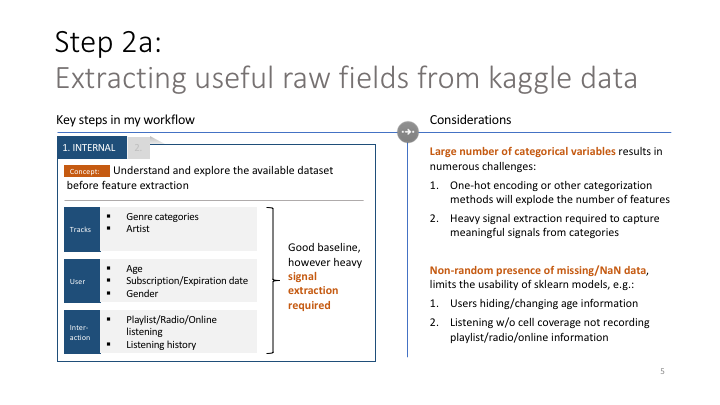
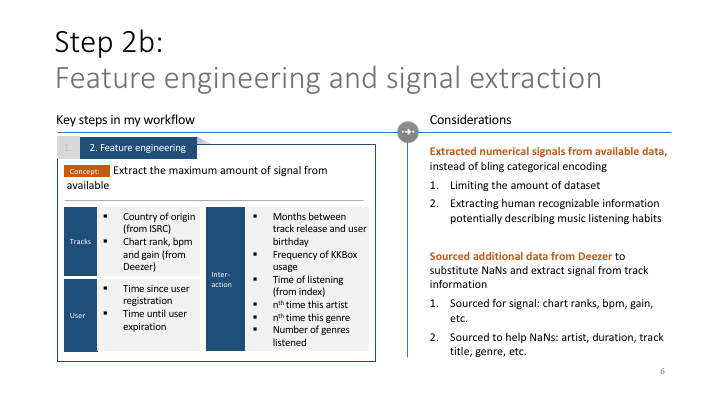
def full_songs_engineering(df_full_songs):
'''
input: df_full_songs
output: df_full_songs cleaned and engineered
'''
# Extract country of origin from isrc
df_full_songs['song_language_isrc'] = np.where(df_full_songs['isrc'].isna(),
np.NaN,
df_full_songs['isrc'].astype(str).str[:2])
# Count the number of genre_ids
df_full_songs['count_genre_ids'] = df_full_songs['genre_ids'].str.count('\|')+1
# Categorize genre (can be multiple)
dfs=[]
df_all_genres = pd.DataFrame(df_full_songs['genre_ids'].str.split('|',expand=True)).fillna(value=np.NaN)
for i, column in enumerate(df_all_genres):
dfs.append(pd.get_dummies(df_all_genres[i], prefix = 'genre_CAT'))
df_genre_merged = pd.concat(dfs, axis=1)
df_genre_merged = df_genre_merged.groupby(df_genre_merged.columns, axis=1).agg(np.max)
df_full_songs = pd.concat([df_full_songs, df_genre_merged], axis=1)
del df_genre_merged
del df_all_genres
del dfs
return df_full_songsdef members_engineering(df_members):
'''
input: df_members
output: df_members cleaned, and features engineered
'''
## 'bd', aka age of user has outliers and bias
# Replace ages >90 years with 90 years in df_members/user age
df_members['bd'] = df_members['bd'].apply(lambda x: x if x<=90 else 90)
# Replace ages <0 years with np.NaN in df_members/user age
df_members['bd'] = df_members['bd'].apply(lambda x: x if x>=0 else np.NaN)
# Replace 0s to np.NaN in df_members/user age
df_members['bd'].replace(0,np.NaN,inplace=True)
## Formatting date columns
df_members['registration_init_time'] = df_members['registration_init_time'].apply(lambda x: pd.to_datetime(x, format='%Y%m%d'))
df_members['expiration_date'] = df_members['expiration_date'].apply(lambda x: pd.to_datetime(x, format='%Y%m%d'))
# Calculate the time between user registration and today (ca. 2017-Jan-31)
df_members['days_since_registration'] = df_members['registration_init_time'].apply(lambda x: (pd.to_datetime('20170131') - x).days)
# Calculate the time between user expiration and today (ca. 2017-Jan-31)
df_members['days_until_expiration'] = df_members['expiration_date'].apply(lambda x: (x - pd.to_datetime('20170131')).days)
# Categorize "gender" on df_members
gender_CAT = pd.get_dummies(df_members['gender'], prefix = 'gender_CAT')
df_members = pd.concat([df_members, gender_CAT], axis=1)
del gender_CAT
# Calculate the difference between the age of the song and the age of the user (57% NaN ratio)
df_members['days_since_registration'] = df_members['registration_init_time'].apply(lambda x: (pd.to_datetime('20170131') - x).days)
return df_membersdef train_engineering(df_train):
'''
input: df_train
output: df_train cleaned and engineered
'''
# Categorize "screen of listening" on df_train (1: create screen_id, 2: categorize)
df_train['screen_id'] = df_train['source_system_tab']+'+'+df_train['source_screen_name']+'+'+df_train['source_type']
screen_id_CAT = pd.get_dummies(df_train['screen_id'], prefix = 'screen_id_CAT')
df_train = pd.concat([df_train, screen_id_CAT], axis=1)
del screen_id_CAT
# Count number of songs each user has listened to
df_activity_temp = pd.DataFrame(df_train.groupby(by='msno')['song_id'].nunique()).reset_index()
df_activity_temp.columns = ['msno','user_activity']
df_train = df_train.merge(df_activity_temp,how='left',on='msno')
del df_activity_temp
return df_traindef merge_databases(df_train, df_members, df_full_songs):
'''
input: df_train, df_members, df_full_songs
output: df_merged
'''
df_merged = (df_train.merge(df_members, on='msno', how='left')
.merge(df_full_songs, on='song_id', how='left')
)
return df_mergeddef merged_engineering(df_merged):
'''
input: df_merged
output: df_merged cleaned and engineered
Notes: this function is very very heavy. To run properly on large dfs, it requires AWS and chunkified dfs
'''
# nth time listening to this artist
msno_group = df_merged.groupby(by='msno')
print('*** Group by done')
KKBOX = np.array(msno_group['artist_name_x'].nunique())
DEEZER = np.array(msno_group['artist_name_y'].nunique())
print('*** Uniques found')
df_artist_freq = pd.DataFrame({'msno':np.array(list(msno_group.groups.keys())),'artist_freq':np.where(KKBOX>DEEZER,KKBOX,DEEZER)})
df_artist_freq.columns = ['msno','artist_freq']
print('*** Frequencies in df')
print('*** Merge starting')
df_merged = df_merged.merge(df_artist_freq,how='left',on='msno')
print('*** Merge finished')
del df_artist_freq
# number of genres listened
df_merged['genre_ids'] = df_merged['genre_ids'].str.replace('|',r',')
print('*** Replace of | to , finished')
df_grouped = (df_merged
.groupby('msno',as_index=False)
.agg({'genre_ids':(lambda x: x.str.cat(sep=',').split(','))})
.rename(columns={'genre_ids':'all_genres_listened'})
)
print('*** Groupby finished')
df_grouped['number_of_genres_listened'] = df_grouped['all_genres_listened'].swifter.apply(lambda x: len(set(x)))
print('*** Set creation finished')
print('*** Merge starting')
df_merged = df_merged.merge(df_grouped, on='msno',how='left')
print('*** Merge finished')
del df_grouped
print('Finished number of genres listened')
# nth time listening to this genre - apply function
def check_genres(row):
counter = 0
prev_counter = 0
for item in row['all_genres_listened']:
multi_counter = 0
if ',' in str(row['genre_ids']):
for genre in row['genre_ids'].split(','):
if item == genre:
multi_counter += 1
if prev_counter > multi_counter:
multi_counter = prev_counter
prev_counter = multi_counter
else:
if item == row['genre_ids']:
counter += 1
return counter if counter > multi_counter else multi_counter
# nth time listening to this genre - runner
print('*** Starting nth time this genre')
df_merged['n_th_time_this_genre'] = df_merged.swifter.apply(check_genres,axis=1)
return df_merged3. Codifying often (re-)used functions
In this step I am defining functions that are often required and re-run in the (following) model building step. The functions are not run in the order of this notebook, but rather as-required.
3.1. Chunkifier: Read a database ‘chunkified’, i.e. in smaller pieces. This is helpful when the computation is very memory or cpu hungry
def chunk(seq, size):
return (seq[pos:pos + size] for pos in range(0, len(seq), size))
# usage: for i, df_chunk in enumerate(chunk(df_merged_final, 100000)):3.2. Pickle reader: For some reason pandas’ built-in pickle reader did not cope with the challenge to read some of my pickles, hence I built the below substitute function
# This unpickler was more reliable than pd.read_pickle
# filename = 'df_merged_merged_aws.pkl'
def own_read_pickle(filename):
import pickle as pkl
objects = []
print(f'Pickle load of {filename} started')
with (open(filename, 'rb')) as openfile:
while True:
try:
objects.append(pkl.load(openfile))
except EOFError:
break
df_output = objects[0]
print(f'Pickle load of {filename} finished')
return df_output3.3. Model scorer: The below function provides the most important scoring metrics to evaluate model performance and returns the confusion matrix that provides the absolute figures behing these scoring metrics.
def score_model(model, X, y, gbm=False):
# Calculate hard predictions
if gbm:
prediction_hard = model.predict(X,ntree_limit=model.best_ntree_limit)
else:
prediction_hard = model.predict(X)
print('score_model: Predictions ready')
# Score model on FBeta weighing on precision
beta=0.3
print(f'FBeta(b={beta}) score is: {fbeta_score(y, prediction_hard,beta)}')
# Calculate confusion matrix
conf_matrix = confusion_matrix(y, prediction_hard)
TN, FP, FN, TP = conf_matrix.ravel()
## Scoring
Recall = TP / (TP + FN)
Precision=TP/(TP+FP)
Specificity = TN / (TN + FP)
Accuracy=(TP+TN)/(TP+TN+FP+FN)
print('Accuracy:',Accuracy)
print('Recall:',Recall)
print('Precision:',Precision)
print('Specificity:',Specificity)
# Print confusion matrix
return pd.DataFrame(conf_matrix, columns=
['Predict (0=no relisten)', 'Predict (1=relisten)'],
index=['Actual (0=no relisten)', 'Actual (1=relisten)'])4. Building the model
4.0. Create df_X by compiling ‘useful’ features and the target
This is step 0, i.e. loading the data and selecting feature-columns we (may) require. This is not to be confused with feature-selection, in this case I am loading all features that may or may not help the model.
def select_columns(df_in, target_removed=True):
cols_not_required = ['song_id','source_system_tab','source_screen_name',
'source_type','gender','city','registered_via','registration_init_time',
'expiration_date','name','isrc','genre_ids','artist_name_x','composer',
'lyricist','language','track_title','album_title','artist_name_y',
'release_date','duration_sec','song_language_isrc','screen_id','all_genres_listened'
]
df_out = df_in.drop(cols_not_required,axis=1)
if target_removed:
df_out = df_out.drop(['target'],axis=1)
return df_out
def load_dataset(filename, sample=False):
df_merged = own_read_pickle(filename)
print('load_dataset: df_merged loaded into memory')
# Sample creation if needed
if sample:
list_of_chunks = get_user_split_data(df_merged,100000)
df_sample = list_of_chunks[0]
#df_sample = pd.read_pickle('df_sample_modeltraining.pkl')
df_merged = df_sample
print('load_dataset: sample creation done')
df_X = select_columns(df_merged,target_removed=True).reset_index()
df_X.rename({'index':'time_proxy'},axis=1,inplace=True)
df_y = df_merged[['msno','target']]
print('load_dataset: df_X,df_y created')
return df_X, df_y4.1. Checking distribution of the target
Checking the target distribution guides us whether class-imbalance measures are required. In this case the classes are balanced almost spot-on evenly.
y_train = pd.DataFrame(own_read_pickle('y_train.pkl'))
target_pcts = df_y['target'].value_counts(normalize=True)
print(target_pcts)
target_pcts.plot(kind='bar')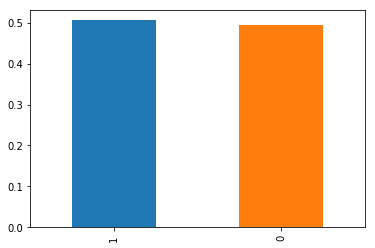
4.2. Decide which scoring metric to optimize on
- target metrics have no imbalance
- it is not crucial to catch all ‘positive’ cases, nor are we interested in negative cases
- key is high precision, i.e. out of all music recommendations we want the highest number actual interesting ones, and rather recommend less but more precisely
- however fully leaving recall out, would be biased
- score of choice: FBeta (beta = 1⁄3, i.e. giving more weight to precision)
4.3. Split into train-test-validation taking user-based split
Train-test-validation split is key to tune and evaluate model performance. In our case the data is already naturally split by users (listening to overlapping songs), and keeping each user in only one of the splits seems like a logical choice. I had the guiding thought that I want to learn from the behaviour of one user and apply it to another.
Side-note: Another potential split would be based on time, i.e. I am learning from any user’s past behaviour to predict the future. However in our case the data does not have an explicit time dimension, as the re-listening targets given already give sneak peak into the future.
def get_user_split_data(df, chunksize = 100000):
# list of unique users
all_users = df['msno'].unique()
number_of_users = all_users.shape[0]
len_df = df.shape[0]
chunknumbers = ceil(len_df / chunksize)
userchunks = ceil(number_of_users/chunknumbers)
df_chunks=[]
for i in range(1,chunknumbers+1):
print(f'Creating chunks {i} of {chunknumbers}')
users_in_chunk = all_users[(i-1)*userchunks:i*userchunks]
df_chunks.append(df[df['msno'].isin(users_in_chunk)])
print('All chunks created')
return df_chunksdef get_user_split_data_train_test(df_X, df_y, test_size=.2, seed=42):
rs = np.random.RandomState(seed)
total_users = df_X['msno'].unique()
test_users = rs.choice(total_users,
size=int(total_users.shape[0] * test_size),
replace=False)
X_tr = df_X[~df_X['msno'].isin(test_users)]
X_te = df_X[df_X['msno'].isin(test_users)]
y_tr = df_y[~df_y['msno'].isin(test_users)]
y_te = df_y[df_y['msno'].isin(test_users)]
return X_tr, X_te, y_tr, y_tedef split_data(df_X,df_y):
# 20% for testing and 20% for validation
# Getting: X_train, y_train + X_val, y_val + X_test, y_test
X_train_val, X_test, y_train_val, y_test = get_user_split_data_train_test(df_X,df_y,test_size=0.2)
X_train, X_val, y_train, y_val = get_user_split_data_train_test(X_train_val,y_train_val,test_size=0.25)
print('split_data: train_test split on a user base finished')
# Dropping msno columns, which was kept for user-based splitting
X_train = X_train.drop(['msno'],axis=1)
y_train = y_train.drop(['msno'],axis=1)
X_val = X_val.drop(['msno'],axis=1)
y_val = y_val.drop(['msno'],axis=1)
X_test = X_test.drop(['msno'],axis=1)
y_test = y_test.drop(['msno'],axis=1)
y_train = np.array(y_train).reshape(y_train.size,)
y_val = np.array(y_val).reshape(y_val.size,)
y_test = np.array(y_test).reshape(y_test.size,)
print('split_data: msno dropped, y-s reshaped')
del df_X, df_y, X_train_val, y_train_val
return X_train, y_train, X_val, y_val, X_test, y_test4.4. Preparing a baseline model
Building a baseline model is helpful to have a benchmark for later models. In the baseline model I am only using a few seemingly important features to understand how much of the target’s variance is explained when still keeping things simple.
from sklearn.linear_model import LogisticRegression
from sklearn.metrics import fbeta_score, confusion_matrix
from sklearn.preprocessing import StandardScaler
X_train_small = X_train[['user_activity','artist_freq','number_of_genres_listened','n_th_time_this_genre']].astype(float)
X_val_small = X_val[['user_activity','artist_freq','number_of_genres_listened','n_th_time_this_genre']].astype(float)
# Scale X_train to same scale
std_scale = StandardScaler()
X_train_scaled = std_scale.fit_transform(X_train_small)
X_val_scaled = std_scale.fit_transform(X_val_small)
# Apply logistic regression
lr = LogisticRegression(solver='lbfgs')
lr.fit(X_train_scaled, y_train)
score_model(lr, X_val_scaled, y_val)FBeta(b=0.3) score is: 0.8145705294249105
Accuracy: 0.5380899961808909
Recall: 0.8510212418300653
Precision: 0.5519114101782923
Specificity: 0.1556931063744821
| Predict (0=no relisten) | Predict (1=relisten) | |
|---|---|---|
| Actual (0=no relisten) | 3119 | 16914 |
| Actual (1=relisten) | 3647 | 20833 |
4.5. Check pairplots if linear separation is possible
Pairplots show the relationships between all features and between each feature and the target. This latter is what we are interested in, specifically looking for separations of the target along the axis of the feature
Note: it is the bottom row of the pairplot in my case, and the linear separation by each features individual contribution is relatively low, i.e. there is no very clear groups being formed along the different values on the features x-axis
sns.pairplot((select_columns
(df_sample,target_removed=False)
[['user_activity','artist_freq','number_of_genres_listened','n_th_time_this_genre','target']]),
hue='target')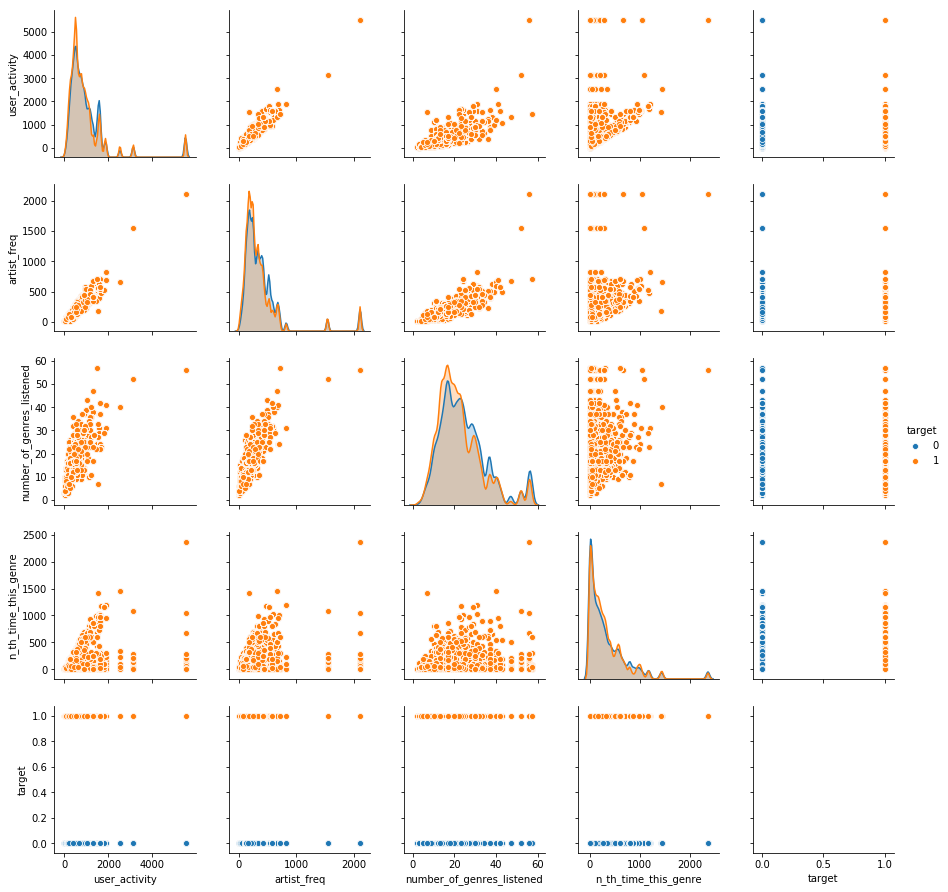
4.6. Tree-based models
Switching to tree-based methods given low (accuracy) scores in logistic regression, clear bias towards positive predictions, and low visible separatability inferrable from the pairplots.
Random-forest classifier
from sklearn.metrics import fbeta_score, confusion_matrix
from sklearn.ensemble import RandomForestClassifier
import xgboost as xgb# Select dataframes
X_train_small = X_train[['user_activity','artist_freq','number_of_genres_listened','n_th_time_this_genre']].astype(float)
X_val_small = X_val[['user_activity','artist_freq','number_of_genres_listened','n_th_time_this_genre']].astype(float)# Random forest for baseline
rf = RandomForestClassifier(n_estimators = 1000, max_features = 3, min_samples_leaf = 4, n_jobs=-1)
rf.fit(X_train_small,y_train)RandomForestClassifier(bootstrap=True, class_weight=None, criterion='gini',
max_depth=None, max_features=3, max_leaf_nodes=None,
min_impurity_decrease=0.0, min_impurity_split=None,
min_samples_leaf=4, min_samples_split=2,
min_weight_fraction_leaf=0.0, n_estimators=1000, n_jobs=-1,
oob_score=False, random_state=None, verbose=0,
warm_start=False)
# Random forest scoring
score_model(rf, X_val_small, y_val)FBeta(b=0.3) score is: 0.797741149918771
Accuracy: 0.5452789072855121
Recall: 0.8297794117647059
Precision: 0.5582488251298541
Specificity: 0.19762392053112365
| Predict (0=no relisten) | Predict (1=relisten) | |
|---|---|---|
| Actual (0=no relisten) | 3959 | 16074 |
| Actual (1=relisten) | 4167 | 20313 |
XG Boost classifier
# Gradient boosting
gbm = xgb.XGBClassifier(
n_estimators=30000,
max_depth=4,
objective='binary:logistic', #new objective
learning_rate=.005,
subsample=.8,
min_child_weight=3,
colsample_bytree=.8,
n_jobs=-1
)
eval_set=[(X_train_small,y_train),(X_val_small,y_val)]
fit_model = gbm.fit(
X_train_small, y_train,
eval_set=eval_set,
eval_metric='error', #new evaluation metric: classification error (could also use AUC, e.g.)
early_stopping_rounds=50,
verbose=False
)
score_model(gbm, X_val_small, y_val)FBeta(b=0.3) score is: 0.9040621810095893
Accuracy: 0.554849145193539
Recall: 0.9582516339869281
Precision: 0.5552057939457055
Specificity: 0.061897868516947036
| Predict (0=no relisten) | Predict (1=relisten) | |
|---|---|---|
| Actual (0=no relisten) | 1240 | 18793 |
| Actual (1=relisten) | 1022 | 23458 |
4.7. Extending the model
As the above results still can take improvements, below I am using an automatic feature selection mechanism and tweaking the hyperparameters of XG Boost (using trial-and-errors)
def tree_modelrun(X_train,y_train,X_val,y_val, xgb, select_thresh=0,select_model=None):
if xgb:
if select_thresh>0:
from sklearn.feature_selection import SelectFromModel
selection = SelectFromModel(select_model, threshold=select_thresh, prefit=True)
X_train = selection.transform(X_train)
X_val = selection.transform(X_val)
# Gradient boosting
model = xgb.XGBClassifier(
n_estimators=30000,
max_depth=12,
objective='binary:logistic', #new objective
learning_rate=.01,
subsample=.8,
min_child_weight=4,
colsample_bytree=.2,
n_jobs=-1
)
eval_set=[(X_train,y_train),(X_val,y_val)]
fit_model = model.fit(
X_train, y_train,
eval_set=eval_set,
eval_metric='error', #new evaluation metric: classification error (could also use AUC, e.g.)
early_stopping_rounds=50,
verbose=True
)
else:
# Random forest for baseline
model = RandomForestClassifier(n_estimators = 1000, n_jobs=-1)
model.fit(X_train,y_train)
print(score_model(model, X_val, y_val))
return model4.8. Plotting feature importance from XG Boost
def param_importance(gbm,num):
gain = gbm.get_booster().get_score(importance_type='gain')
return xgb.plot_importance(gbm,max_num_features=num), xgb.plot_importance(gbm, importance_type='gain',max_num_features=num), gain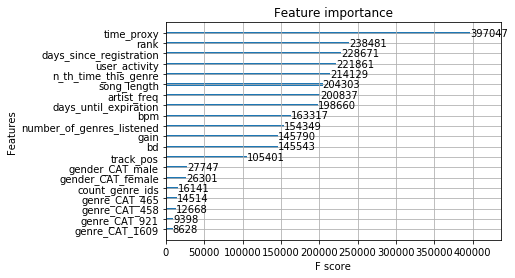

5. – MAIN – Pulling things together
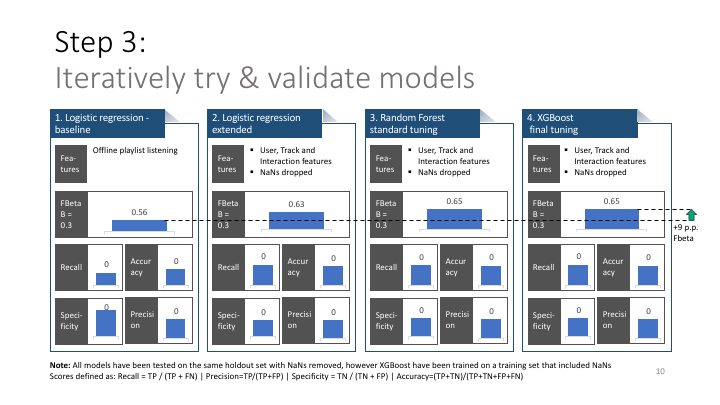
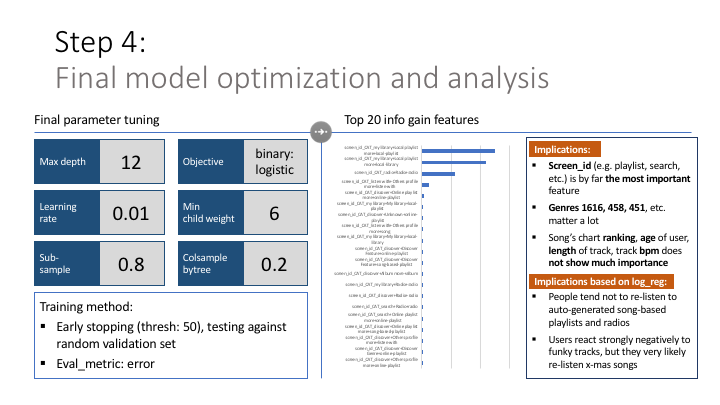
def feature_engineering():
start = time.time()
print('starting',start)
df_train, df_members, df_full_songs = read_in_data(sample=True)
print('Data loaded. Elapsed:',round((time.time() - start)/60,1),'minutes')
df_merged = merge_databases(df_train, df_members, df_full_songs)
print('df_merged created',round((time.time() - start)/60,1),'minutes')
df_merged.to_pickle('df_merged_premod.pkl',protocol=3)
print('df_merged premod pickled',round((time.time() - start)/60,1),'minutes')
del df_train, df_members, df_full_songs
print('individual dfs deleted',round((time.time() - start)/60,1),'minutes')
df_merged = full_songs_engineering(members_engineering(train_engineering(df_merged)))
dfs=[]
all_chunks = get_user_split_data(df_merged,100000)
number_of_chunks = len(all_chunks)
for i, df_chunk in enumerate(all_chunks):
print(f'initiating chunk number {i} of {number_of_chunks}')
dfs.append(merged_engineering(df_chunk))
print(f'finished chunk number {i} of {number_of_chunks} in',round((time.time() - start)/60,1),'minutes')
with open('merged_engineered_list_preconcat.pkl', 'wb') as handle:
pkl.dump(dfs, handle, protocol=pkl.HIGHEST_PROTOCOL)
print(f'list pkl saved',round((time.time() - start)/60,1),'minutes')
print(f'concat starting at',round((time.time() - start)/60,1),'minutes')
df_merged_postmod = pd.concat(dfs)
print(f'concat finished at',round((time.time() - start)/60,1),'minutes')
print(f'pickle starting at',round((time.time() - start)/60,1),'minutes')
df_merged_postmod.to_pickle('df_merged_final_postmod.pkl',protocol=3)
print(f'pickle finished at',round((time.time() - start)/60,1),'minutes')
print(f'Script finished in',round((time.time() - start)/60,1),'minutes')
print('*'*50)def model_creation():
start = time.time()
start_format = time.strftime("%Y%m%d-%H%M%S")
print(f'model_creation() started {start_format}')
print('*'*25,' load_dataset initializing ','*'*10,round((time.time() - start)/60,1),'minutes')
df_X, df_y = load_dataset('df_merged_final_postmod_aws.pkl', sample=False)
print('*'*25,' load_dataset finished ','*'*10,round((time.time() - start)/60,1),'minutes')
print('*'*25,' split_data initializing ','*'*10,round((time.time() - start)/60,1),'minutes')
X_train, y_train, X_val, y_val, X_test, y_test = split_data(df_X,df_y)
print('*'*25,' split_data finished ','*'*10,round((time.time() - start)/60,1),'minutes')
del df_X, df_y
X_train = X_train.astype(float)
X_val = X_val.astype(float)
X_test = X_test.astype(float)
print('*'*25,' xgboost_modelrun initializing ','*'*10,round((time.time() - start)/60,1),'minutes')
gbm2 = xgboost_modelrun(X_train,y_train,X_val,y_val)
print('*'*25,' xgboost_modelrun finished ','*'*10,round((time.time() - start)/60,1),'minutes')
# save the model to disk
print('*'*25,' pickle initializing ','*'*10,round((time.time() - start)/60,1),'minutes')
filename = time.strftime("%Y%m%d-%H%M%S") + '_xgb_aws_model.sav'
pkl.dump(gbm2, open(filename, 'wb'))
print('*'*25,' pickle finished ','*'*10,round((time.time() - start)/60,1),'minutes')
print('*'*50)
print('*'*25,' model_creation() finished ','*'*10,round((time.time() - start)/60,1),'minutes')def final_scoring():
start = time.time()
start_format = time.strftime("%Y%m%d-%H%M%S")
print(f'model_creation() started {start_format}')
X_test = own_read_pickle('X_test.pkl')
y_test = own_read_pickle('y_test.pkl')
y_test = y_test[~X_test.isnull().any(axis=1)]
X_test = X_test.dropna()
with open('X_test_dropna.pkl', 'wb') as handle:
pkl.dump(X_test, handle, protocol=pkl.HIGHEST_PROTOCOL)
with open('y_test_dropna.pkl', 'wb') as handle:
pkl.dump(y_test, handle, protocol=pkl.HIGHEST_PROTOCOL)
X_train = own_read_pickle('X_train_dropna.pkl')
y_train = own_read_pickle('y_train_dropna.pkl')
print('*'*50,round((time.time() - start)/60,1),'minutes')
## 1. Logistic regression - baseline
print('Logistic regression baseline')
X_train_small = pd.DataFrame(X_train['screen_id_CAT_my library+Local playlist more+local-playlist'])
X_test_small = pd.DataFrame(X_test['screen_id_CAT_my library+Local playlist more+local-playlist'])
lr = LogisticRegression(solver='lbfgs')
lr.fit(X_train_small, y_train)
print(score_model(lr, X_test_small, y_test))
filename = time.strftime("%Y%m%d-%H%M%S") + '_logbaseline_aws_model.sav'
pkl.dump(lr, open(filename, 'wb'))
del lr
print(f'Saved as {filename}')
def othermodels():
print('*'*50,round((time.time() - start)/60,1),'minutes')
## 2. Logistic regression - extended
print('Logistic regression extended')
std_scale = StandardScaler()
X_train_scaled = std_scale.fit_transform(X_train)
X_test_scaled = std_scale.fit_transform(X_test)
lr2 = LogisticRegression(solver='lbfgs')
lr2.fit(X_train_scaled, y_train)
print(score_model(lr2, X_test_scaled, y_test))
filename = time.strftime("%Y%m%d-%H%M%S") + '_logextended_aws_model.sav'
pkl.dump(lr2, open(filename, 'wb'))
del lr2
print(f'Saved as {filename}')
print('*'*50,round((time.time() - start)/60,1),'minutes')
## 3. Random forest model
print('Random forest extended')
rf = RandomForestClassifier(n_estimators = 1000, n_jobs=-1)
rf.fit(X_train,y_train)
print(score_model(rf, X_test, y_test))
filename = time.strftime("%Y%m%d-%H%M%S") + '_RF_aws_model.sav'
pkl.dump(rf, open(filename, 'wb'))
del rf
print(f'Saved as {filename}')
print('*'*50,round((time.time() - start)/60,1),'minutes')
## 4. Final xgboost model
print('XGBoost final')
xgb = pkl.load(open("20181029-155308_xgb_aws_model(full v4).sav", "rb"))
print(score_model(xgb, X_test, y_test))
print(f'Saved as 20181029-155308_xgb_aws_model(full v4).sav')